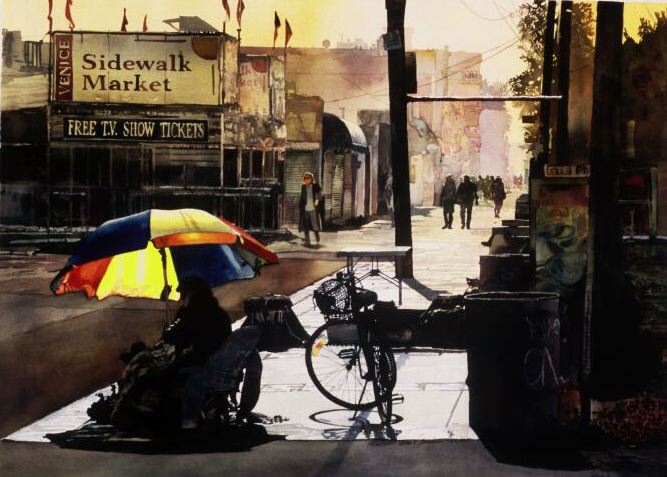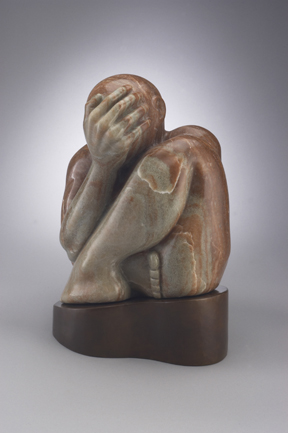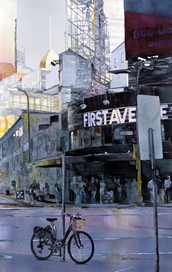State Fair Winners: Watercolor and Sculpture
John Salminen and Richards Poey are the first prize winners in watercolor painting and sculpture. Read on for some background on these interesting artists, and visit their work both on mnartists.org and in the Fine Arts Building at the State Fair.



Watercolor
John T Salminen, Duluth
“First Avenue” (Watercolor)
John Salminen spent many years as a well-loved teacher of art at Central High School in Duluth while pursuing his painting career. He retired from Central in 2001, but didn’t stop teaching—now he leads watercolor workshops and master classes all over the country. He’s looking forward to teaching one in October in Duluth, if you’re interested in learning from this master of the medium. Watercolor sometimes can have a lightweight aura, but in Salminen’s hands it has real aesthetic muscle. His means are traditional–transparent watercolor on paper. His subject matter, though, is less familiar fare at watercolor shows. He concentrates on urban landscapes, often of specific sites in New York, sometimes in Los Angeles, Chicago, San Francisco. For the State Fair he often does a site in Minneapolis.
In his working process, photography has replaced drawing on site. This was also a means used by Thomas Eakins, a precursor in many ways—both artists have done work in resonantly empirical styles, full of light effects and strong compositions that seem to pull significance up to the very skin of the subject. As did Eakins, Salminen photographs his subjects himself. He uses using a telephoto lens, 70mm-300mm, which allows him to do a lot of composing of the image
Salminen says, “I look for images with a strong design component, even more than content, and I often have to do a lot of manipulation afterwards, adding in figures, changing what’s there, since the photos often don’t live up to my experience of the site, the sights and smells, the whole experience of the scene. It’s my job to restore what I saw and felt.”
Salminen’s paintings, while using the camera’s perspective, tend not to look like photographically derived work—as he says, “My role as artist is to reenergize the image.” The great density and charged atmosphere of the paintings, a kind of mirror of the perceiving, multisensory self, creates not simply a specular or visual reality but an inner reality that arises through the detail, light, color, and perhaps most important, the lines of force that push and pull through the composition of the painting. The paint is as thin as air but the image is thick with atmosphere. It’s a lovely paradox.
Sculpture
Richards D Poey, Eden Prairie
“Job’s Torment” (Alabaster on bronze)
Richards Poey was born in New York, and originally was an English major, not an artist. He joined the Navy during Berlin crisis and Cuban crisis, worked for Eastman Kodak in their publicity department, and moved with his family to Minnesota the day of the moon landings. Here, he worked for Honeywell for 28 years in communications. Retired early, in 1997, and started doing sculpture. The Minnetonka Arts Center provided him with the means to do bronze work in their foundry. “To me,” he remarks, “it’s important to know the production end, to get good results.” He’s always pursued more knowledge of his chosen medium, and took lessons in Scottsdale from Stanly Blifeld, Lincoln Fox, and Peter Rubino, He’s since studied stone carving, working mostly in alabaster and marble, often paired with bronze elements.He’s most known for his series called “The Human Condition”: penguins with human feet that allegorize human behaviors—often wittily. One of these will be in the Sioux Falls sculpture walk this year, along with a small bronze figurative piece.
He describes the process of working on “Job’s Torment” this way: “I started with a big chunk of stone, fairly squat. I was looking to do a figurative male piece, and it had to fit the shape. I was struck by a photo of a man holding his head. So I asked a preacher friend of mine, ‘Who’s the most tormented man you know?’ he said Job. So I read up on the story. I started with the hand, the dominant form in the piece. It wasn’t until I got the hand that I really got my direction I was lucky in the figure of the stone, the colors, The piece tries to portray how Job must have felt after losing all his possessions, his family, and still tried to retain his faith.” Poey cast the bronze base himself, to accommodate the difficult shape of the stone.
Poey is not religious, he notes; the story of Job was chosen for its human qualities. Most of his work, he says, has to do with beauty, love, and human relations.
Richards Poey is past president, now vice president, of the Society of Minnesota Sculptors. This organization was founded in 1943 by Katherine Nash and Peter Lepoure, but had become inactive. Poey and several other sculptors were asked by Nick Legaros to join and revive the group, which now has over 60 members.